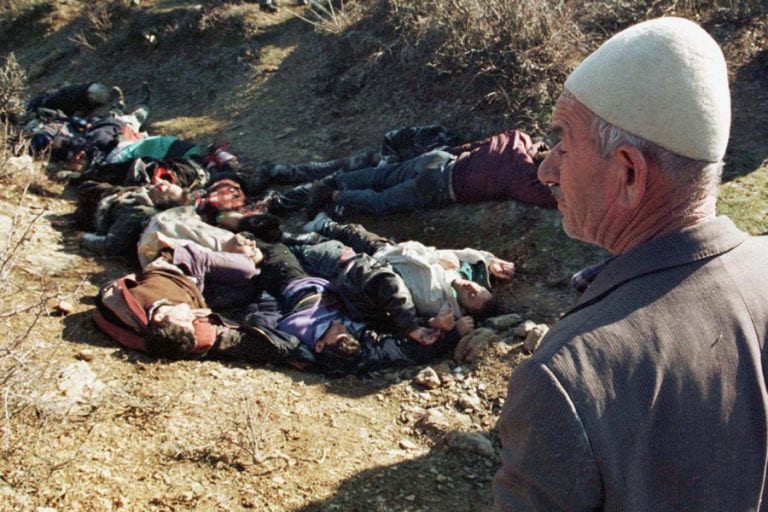In conjunction with the White House, the State Department launched a propaganda blitz to convince the American people that Americans ought to get more deeply involved militarily in the Yugoslavia conflict. Only about half the public, according to various opinion polls, bought into it. But it’s not for lack of trying. A survey of major media programs over a five day period, March 23rd through March 28th, showed twelve different appearances by administration spokesmen.
Typically, the administration alleges that human rights abuses require the United States to intervene. One of the justifications for the 1999 bombing campaign was an alleged Serb massacre of civilians in the village of Racak in Kosovo in January. Referring to this incident, Clinton claimed in his national television address that, “We?ve seen innocent people taken from their homes, forced to kneel in the dirt and sprayed with bullets; Kosovar men dragged from their families, fathers and sons together, lined up and shot in cold blood.” During a three-day period in January, this alleged massacre was the subject of press statements or news conferences by U.N. Secretary-General Kofi Annan, NATO Secretary General Javier Solana, and Secretary of State Madeleine Albright.
But did it happen? Chronicles magazine has just published its own analysis of what is known about this incident and concludes that the deaths could very well have resulted from a firefight between Serb military police and terrorists with the Kosovo Liberation Army, the KLA. One of the undisputed facts of the story is that dead bodies were found in a ravine. The key question is how they got there and how they died.
The Administration claim is that these were civilians herded into a ravine by the Serbs and then shot at point-blank range. But Chronicles assembled a great deal of evidence from journalists who were on the scene that they were KLA fighters who had been hiding in the ravine, using it as a bunker, and then opened fire on the Serb police. The Serbs returned fire, killing them.
Two groups of pathologists have examined the bodies. One from the country of Belarus said the victims were killed by bullets fired from a considerable distance. However, this group found evidence of additional bullets being fired at the dead bodies at close range. It also found evidence that the clothing of some of the victims had been changed. This was based on the fact that the damage to the clothing didn’t match the wounds to the body. This suggests that KLA uniforms were removed from the bodies and different clothes put on them in order to make the victims look like civilians. It suggests that the dead bodies were pumped full of bullets at close range to make it appear that the Serbs had committed a massacre of those civilians.
The report by a team from Finland disagreed with some of the findings of the Belarus team. It satisfied neither the Albanians nor the Serbs. The head pathologist said that there had been a crime against humanity, but she refused to call it a massacre or blame the Serb security forces.
Here is how it was described in “War in Europe“:
“On that very day [Jan. 15, the day the Senate trial of President Clinton began] … the road in Kosovo had turned fatefully toward war. The Serbs had come to Racak with vengeance on their minds. Four of their policemen had been killed by the KLA. Now, the village of Racak would pay. Forty-five Kosovars were killed. A new effusion of blood on the world’s television screens.” As those words were spoken, footage taken by an Associated Press, or AP, camera crew showed Serb security forces approaching and then moving through Racak. Artillery fire could be heard and a Serb officer was shown firing a mortar. There was no sign of any villagers in the streets. The AP says that the footage taken that day did not show any dead bodies.
If the Serbs went to Racak with the intention of murdering innocent villagers, they certainly would not have invited an AP camera crew to accompany them. The two AP cameramen later were interviewed by two French reporters, Christofe Chatelot of Le Monde and Renaud Girard of Le Figaro. Chatelot had seen a Serb news release in the afternoon of Jan. 15, after the Serbs had withdrawn, reporting that they had sent forces to Racak, a KLA stronghold, and had killed 15 terrorists. …
Sources: https://www.questia.com/magazine/1G1-61551806/massacre-by-serbs-in-kosovo-was-a-hoax-by-the-kla; http://www.aim.org/media-monitor/was-the-racak-massacre-a-hoax/



